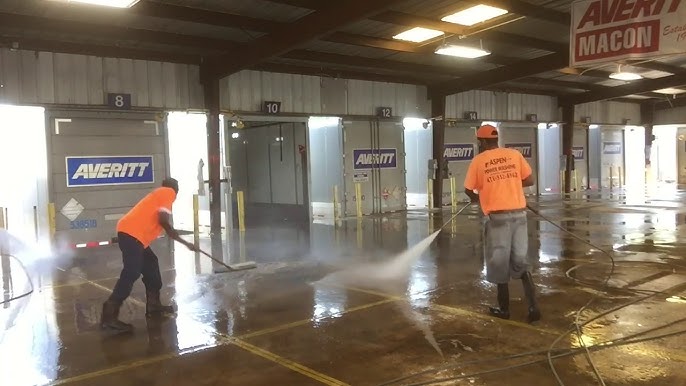
Industrial loading bays and warehouse ramps are essential hubs for commercial operations. Whether you’re dealing with forklift traffic, truck deliveries, or heavy foot traffic, these surfaces take a constant beating. Grease, tire marks, oil spills, dirt, and debris can build up quickly, posing safety hazards and reducing your facility’s professional appearance.
A pressure washer can restore these surfaces to like-new condition—but only if used correctly. In this article, you’ll learn how to safely and efficiently pressure wash industrial loading bays and warehouse ramps without damaging surfaces or disrupting operations. 💼🧼
💡 Why Pressure Wash Industrial Areas?
Routine cleaning helps:
- 🧯 Improve safety by removing oil and grease that can cause slips
- 💼 Maintain a clean professional appearance for clients and vendors
- 🔧 Extend the life of surfaces like concrete or epoxy-coated ramps
- 🛑 Prevent damage from corrosive materials like salt or chemicals
- 🦠 Reduce bacteria, mold, and mildew buildup in shaded areas
🧰 Tools and Equipment You’ll Need
You’ll need heavy-duty gear for industrial cleaning:
- Commercial-grade pressure washer (3,000–4,000 PSI)
- Surface cleaner attachment (ideal for large flat areas)
- 15° (yellow) and 25° (green) spray nozzles
- Degreaser or concrete-safe industrial detergent
- Stiff-bristled brush or broom
- Safety gear (gloves, goggles, steel-toe boots)
- Floor squeegee (optional for water control)
- Wet/dry shop vac (for interior warehouse areas)
⚠️ Some surfaces like epoxy coatings require lower PSI to avoid damage—always test a small section first.
Browse Amazon Here For Top Rated Power Washers And Accessories
🚧 Prep Work Before Cleaning
1️⃣ Clear the Area
- Move pallets, forklifts, boxes, and any stored materials
- Ensure workers and vehicles are out of the wash zone
- Use cones or signage to redirect traffic during cleaning
2️⃣ Sweep the Surface
- Use a broom or blower to remove dust, leaves, cardboard, or debris
- Scrape off any large chunks of mud or hardened material
3️⃣ Protect Sensitive Areas
- Cover electrical outlets or machinery near spray zones
- Use plastic sheeting or tarps to block walls or doors from overspray
- Ensure drains are clear and functioning to prevent runoff buildup
🛠️ Step-by-Step Cleaning Process
1️⃣ Apply Degreaser or Soap
Use a sprayer or foam cannon to coat:
- Greasy patches
- Forklift tire marks
- Oil-stained sections
- Trash bin areas
Let it dwell for 10–15 minutes to break down grime. For tough spots, agitate with a stiff brush before rinsing.
🧪 Use only detergents rated for industrial concrete or sealed surfaces.
2️⃣ Use a Surface Cleaner for Flat Areas
Attach a surface cleaner to your pressure washer for:
- Faster, more uniform results
- Preventing streaks or swirl marks
- Reducing fatigue during large jobs
Move slowly and steadily across the floor. Overlap each pass by 30% for full coverage.
3️⃣ Pressure Wash the Edges and Detail Areas
Switch back to a 15° or 25° nozzle to clean:
- Ramp corners and curbs
- Drainage grates
- Dock edges and bumpers
- Wall baseboards or siding near the floor
Spray at a 45° angle to dislodge grime from cracks and seams.
4️⃣ Rinse the Entire Area
Once scrubbed and cleaned:
- Rinse from back to front to guide water toward the drains
- Use a floor squeegee or broom to push standing water
- For interior zones, use a shop vac to collect excess moisture
Allow proper drying time before resuming vehicle traffic.
🕒 Best Times to Pressure Wash Industrial Zones
| Scenario | Ideal Cleaning Time |
|---|---|
| Busy facilities | Overnight or weekends 🌙 |
| Temperature extremes | Mornings or early evenings ☀️ |
| Seasonal grime buildup | Spring and fall 🌱🍂 |
| Post-construction or renovations | Immediately after completion 🏗️ |
❌ Mistakes to Avoid
- ❌ Using high pressure on epoxy or painted floors
- ❌ Forgetting to isolate drains (risk of chemical runoff)
- ❌ Not warning workers—slip hazards during cleaning
- ❌ Skipping degreaser—water alone won’t lift oil
- ❌ Leaving streaks by overlapping passes too quickly
✅ Aftercare and Maintenance Tips
To keep your industrial surfaces clean between washings:
- Spot-clean weekly with a mop or scrubber
- Use absorbent pads on leak-prone areas (e.g., under trucks)
- Schedule pressure washing quarterly or semi-annually
- Train staff to report spills immediately
Regular maintenance reduces the need for deep cleans and extends surface life.
💬 Final Thoughts
A clean loading bay or warehouse ramp isn’t just about appearance—it’s about safety, efficiency, and professionalism. Pressure washing these high-traffic areas restores traction, reduces liability risks, and helps you meet industry standards.
So fire up that pressure washer, gear up, and give your industrial space the deep clean it deserves. Your facility—and your employees—will thank you. 🏗️💧✅
Browse Amazon Here For Top Rated Power Washers And Accessories



